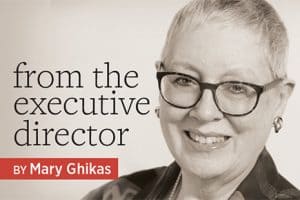
In my last column, I noted that we are engaged—together—in the difficult but essential work of change. This requires that we collaborate in good faith, trusting one another’s commitment to the important work we do at the American Library Association (ALA) and as a profession. It also requires introspection about why we have come together in an association so we retain those fundamental attributes as we move forward.
In the most basic terms, an association is simply a voluntary organization of persons with common interests and ends, joining formally to achieve things they could not achieve—or could not achieve as well—alone. It’s an observation made in the early 1800s in Democracy in America by French historian Alexis de Tocqueville as he witnessed Americans organizing societies around politics, faith, and economics. But Democracy in America was written more than 180 years ago. Times—and technology—have changed.
What does this mean for ALA?
- We are mission-driven, providing “leadership for the development, promotion, and improvement of library and information services and the profession of librarianship in order to enhance learning and ensure access to information for all.”
- We are our members—the essential force for fulfilling our mission.
- We are the formal structure that organizes the work of 58,000 members, as well as staff and others in the “ALA community.”
I am frequently asked why we need associations today. It’s an important question. In thinking about it, we can clarify our assets and our sources of power, and understand the core functions we want to preserve.
First, an association is about persistence: persistence of memory, mission, and effort in the face of time, opposition, and—perhaps most dangerous—indifference. Fighting for libraries, library employees, and the communities they serve is an ongoing necessity that will span generations. So it’s important to consider assets that support this: legal structure and standing, governance and decision making, financial assets, processes, procedures, and more.
Second, an association is about conversation and context, difference and discovery. While ALA is made of individual people and organizations, those individuals are part of the community, the collective. Shared directions are discovered in the push and pull of opposing concepts and differing perspectives. Like libraries, associations can take you out of your comfort zone, within the relative safety of the community.
Third, associations are about active engagement: about accepting, creating, and codesigning participation. This is a process of collaboratively innovating within an association. Each of us must ask, “How do I affect my association in order to contribute my own passion, my vision, my voice, and my skills?”
As we work through the process of change, with its inherent risks, uncertainties, and disagreements, it will be helpful to keep in mind these fundamental “whys” of what we do.
With changes to specific structures and processes, we must remember that these are means to accomplish common aims.
With new models, we must remember to ensure the Association’s ability to persist.
With new recommendations, we must remember there are ways to craft shared direction from differing opinions, perceptions, and experiences.
To me, associations, like libraries, are fundamentally optimistic. While they honor the past, they look forward. They assume continuous learning and improvement.
Let’s acknowledge tradition and base new solutions on our strengths.

